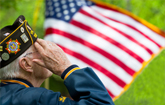
Flying Tigers: Two WWII veterans, over 100, reminisce about wartime camaraderie between China and US|Brothers in Arms ③
GUANGZHOU, China, Oct. 3, 2025 /PRNewswire/ -- News report from GDToday.
As the world in 2025 commemorates the 80th anniversary of victory in the War of Resistance Against Japanese Aggression, the bond forged between Chinese and American servicemen during WWII is brought into renewed focus. Today, with only a handful of centenarian veterans left—one from China and one from the United States—their recent reflections revive the memory of an extraordinary partnership: the Flying Tigers.
In the darkest hours of China's War of Resistance, when cities like Chengdu, Chongqing, and Kunming endured relentless bombing campaigns, this international alliance emerged to change the course of history. The year was 1941, and as China faced its most vulnerable moment, a group of American aviators and Chinese compatriots joined forces to create what would become legendary.
The courageous partnership began when Chinese representatives successfully appealed to President Roosevelt for support, resulting in the Lend-Lease Act that enabled China to acquire 100 P-40 Warhawk aircraft. Under the leadership of retired General Claire Chennault, approximately 100 pilots and 200 support personnel were recruited, including many Chinese Americans eager to defend their ancestral homeland.
As Nell Calloway, the granddaughter of General Chennault, recounts, the Flying Tigers—formally known as the American Volunteer Group (AVG) and later incorporated into the 14th Air Force—performed multiple critical missions: defending the Kunming region, conducting frontline operations, and striking Japanese forces along the Burma Road.
When Japanese troops severed the Burma Road in 1942, the Flying Tigers pioneered the perilous "Hump" route across the Himalayas. Through treacherous weather and without proper equipment, these brave crews transported 736,374 tons of vital supplies to China at tremendous cost—losing 468 aircraft and over 1,340 aircrew members, with 81 planes never recovered.
The Chinese American contribution proved indispensable to this effort. By war's end, more than 1,600 Chinese Americans had served as pilots, mechanics, and interpreters, creating crucial cultural and operational bridges between the allied forces.
Beyond military statistics, the Flying Tigers' story reveals profound humanity. Veterans like Wing Yoke Lai remembered Chinese civilians who risked everything to rescue airmen whose plane was downed, demonstrating extraordinary courage amidst widespread suffering.
President Franklin D. Roosevelt acknowledged China as the first nation to stand against fascist aggression. The cooperation between Chinese and American servicemen not only helped turn the tide in the Pacific theater but also established a foundation for mutual respect and shared purpose.
This spirit of collaboration finds perfect expression in General Chennault's 1949 hope: "It is my fondest hope that the sign of the Flying Tiger will remain aloft just as long as it is needed on both shores of the Pacific, to show two great peoples working toward a common goal in war and peace."
Now, as the number of surviving veterans dwindles, their legacy stands as a powerful testament to what cross-cultural cooperation can achieve. It remains a hope that continues to inspire, calling upon both nations to honor their shared history and work toward a common future.
SOURCE GDToday









Share this article